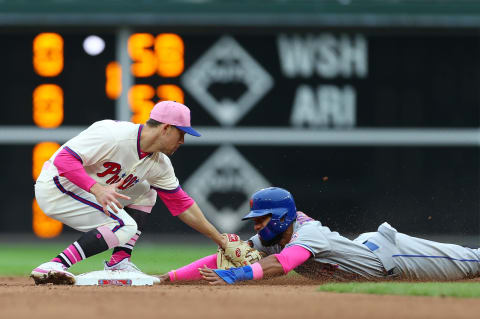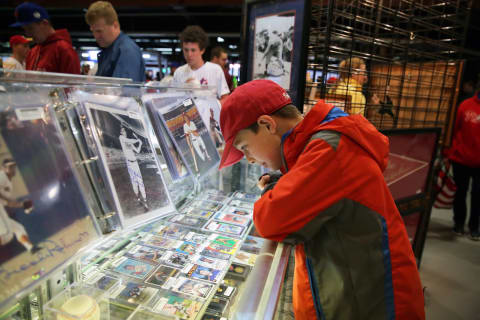Phillies use advanced stats: You should know what they are


The Phillies are diving headfirst into baseball’s advanced statistics, especially with the hire of Gabe Kapler. You should know what they are talking about.
When the Phillies hired Gabe Kapler to be their manager during the offseason, the team made it clear they will rely heavily on advanced metrics and statistics. The club expanded its analytics department significantly the last few years and now have former major-leaguer Sam Fuld in the dugout as the player information coordinator.
However, it’s hard to understand why the team would use advanced statistics when you don’t understand their purpose. To help understand, I’ve compiled a list of the more commonly-used advanced statistics that I often reference in my articles. The Phillies almost certainly use these, if not even more advanced ones that the general public doesn’t even know about.

Offense
- OPS+ – All this is is a standardized version of OPS (on-base plus slugging percentage). 100 is league-average, above is better, below is worse. Mike Trout led the league last year with a 187 OPS+; Rhys Hoskins finished his breakout rookie campaign with a 163 OPS+.
- Weighted On-Base Average (wOBA) – Like OPS, wOBA attempts to measure a player’s overall effectiveness at the plate. wOBA favors getting on base while OPS favors hitting for extra bases. According to Fangraphs, an average player will have a .320 wOBA, while a great one will have a .400 wOBA. Trout also led the league with a .437 wOBA last year, while Andrew Knapp had a .321 wOBA.
- Weighted Runs Created (wRC) – wRC is based off wOBA and measures a player’s offensive values in terms of runs. For example, Odubel Herrera was worth 72 weighted runs created last year. wRC+ is the standardized version of wRC, like OPS+ and OPS. Herrera had a 100 wRC+ last year.
- Weighted Runs Above Average (wRAA) – This stat is also derived from wOBA and indicates how much better or worse a player is compared to the league average. Cincinnati’s Joey Votto was the most valuable player offensively according to wRAA at 64, meaning he was worth 64 runs more than the average major-leaguer over the course of the season.
- Batted Ball Data – This is a broad category as it accounts for where players hit the ball, how hard they hit it, and how long the ball is in the air. The Phillies lean on this heavily to determine where to position their fielders for defensive shifts.

Defense
- Defensive Runs Saved (DRS) – This a statistic that estimates a player’s overall defensive value in terms of runs by aggregating a lot of smaller stats (more can be read about it here on Fangraphs). Essentially, it attempts to measure how many more or less plays a fielder makes compared to an average player at their position. Fangraphs says a player with +15 defensive runs saved is Gold-Glove caliber. Andrelton Simmons of the Angels led the league with 32 defensive runs saved last season.
- Ultimate Zone Rating (UZR) – Like DRS, UZR measures how many runs a player saves defensively. It also aggregates several different components to find its value. UZR/150 simply averages out UZR to the normal numbers of chances in one season. For comparison, Simmons had a 17.5 UZR and 18.5 UZR/150 last year.
- Revised Zone Rating (RZR) – This stat measures how often a player converts a ball hit into their area of the field into an out. For example, Freddy Galvis had 320 balls hit in his zone last year, and he converted 248 of them into outs, so he had a .775 RZR.

Pitching
- Fielding-Independent Pitching (FIP) – This is a statistic I constantly reference as I find it more reliable than ERA. It removes any influence a good or bad defender may have on a play by only looking at the three true outcomes: walks, strikeouts, and home runs. A pitcher who has a 4.50 ERA but a 3.25 FIP likely suffers from bad luck or poor fielding and should perform better in the future. FIP is scaled similarly to ERA, but computed in a different manner.
More from Phillies News
- Phillies-Mets owners’ rivalry grows after shocking Carlos Correa deal
- Could Rich Hill become ‘Jamie Moyer 2.0’ in Phillies rotation?
- Does Bailey Falter have a future in Phillies’ rotation?
- Bryce Harper’s absence should lead to Phillies lineup tinkering
- Pirates’ bizarre Vince Velasquez hype video will make Phillies fans laugh
- Expected Fielding-Independent Pitching (xFIP) – This almost exactly the same as FIP, but xFIP uses a league average amount of home runs rather than the actual number of home runs a pitcher allowed. It better accounts for fluctuations in home run rates, but FIP is used more often as home runs are often attributed to the pitcher.
- Skill-Interactive Earned Run Average (SIERA) – Rather than excluding batted balls like FIP and xFIP do, SIERA incorporates them into how it is calculated. The formula is quite complex, but it allows you to observe how often pitchers can create outs, via either strikeout or batted ball. Like the last two, it also scales with regular ERA.
- Pitch Values – Fangraphs’ pitch value statistic measures how valuable each pitcher’s individual pitch is. It is based on runs above or below average like other statistics mentioned earlier. There are both overall pitch values as well as corrected pitch values, which are based on a 100-pitch basis. Corey Kluber’s curveball had the best corrected value of all curveballs at 4.73, while Justin Verlander’s fastball was worth 33.5 runs above average overall.

Wins Above Replacement (WAR)
Wins above replacement is such an in-depth statistic that I figured I’d save it for the end and give it its own section. WAR is the closest thing we have to a number that can measure a player’s overall value. It states how much value a team would lose if they replaced someone with a generic, just good enough to be in the majors player. Therefore, if a player has a WAR of 2.0, it means he was worth two wins more than that replacement player.
WAR is used for both pitchers and hitters, counting how many runs they were worth overall. It covers every aspect of the game, which would include defense, baserunning, and hitting for position players, as well as some league and position adjustments.
More from That Balls Outta Here
- 11 Free-agent deals the Philadelphia Phillies wish fell through
- Phillies-Mets owners’ rivalry grows after shocking Carlos Correa deal
- Could Rich Hill become ‘Jamie Moyer 2.0’ in Phillies rotation?
- Does Bailey Falter have a future in Phillies’ rotation?
- Prospect Andrew Baker could help Phillies bullpen in 2023
WAR can change depending on where you find it. Fangraphs, Baseball Reference, and Baseball Prospectus all calculate it in their own way, using different numbers to calculate it. For example, Fangraphs uses FIP while Baseball Reference uses runs allowed per nine innings to determine WAR for pitchers. That’s why you could see significantly different WARs for the same player depending on where you look.
In general, an everyday starter should be worth two to three WAR over the course of a season. All-Stars are worth at least four WAR, while MVPs candidates usually are worth over six.
Per Baseball Reference, 2017 NL MVP Giancarlo Stanton was worth 7.6 WAR while AL MVP Jose Altuve was worth 8.3. Meanwhile, AL Cy Young winner Corey Kluber was worth 8.2 WAR while NL winner Max Scherzer was worth 7.1.
There are some stipulations with WAR. It is good at distinguishing a good starter from an All-Star, but it does little to separate two MVP candidates. Three of the top four vote-getters in last year’s NL MVP race (Stanton, Joey Votto, and Nolen Arenado) all fell within 0.4 WAR of each other. In this kind of situation, it is necessary to dive further into the numbers to make a distinction. Ultimately, Stanton was just able to edge out Votto as the vote-getters wound up valuing his lofty home run and RBI total over Votto’s higher batting average and on-base percentage.
Next: Breaking down Williams vs Altherr
Hopefully, this article gives a better understanding of what all these advanced statistics mean. That way when you read them in an article here or somewhere else, you will be able to interpret them effectively. Baseball is moving towards these kinds of stats; you should be ready for it.